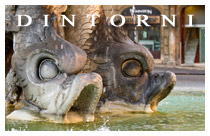
Roma
Around the Via Zucchelli both expected and unexpected Rome.
Water made Rome powerful and all of the citys history is tied to the importation of water over the course of the centuries: from the presence of the Tiber River for the birth and development of the city, to the construction of the aqueducts, to the use of water in the thermal baths of ancient Rome.
Even when the barbarians destroyed Romes eleven existing aqueducts, after 1500 CE thanks to the will of the Pope hundreds of public fountains were rebuilt.
After the restoration of the Vergine Aqueduct the major pontiffs called upon the greatest artists of the time and commissioned works that became masterpieces.
And so the fountains began to live again. No other city in the world has as many fountains as Rome.
The Triton Fountain
At the center of nearby Piazza Barberini rises the baroque Triton Fountain.
Realized in travertine stone by Gian Lorenzo Bernini around 1643, the fountain is one of the most unique in the entire city above all for its naturalism with which the artist fashioned the maritime monster, half man and half fish, seated upon an open shell. Represented with powerful muscles, Triton appears in the act of blowing into a bugle from which, instead of sound, jets of water burst forth and fill up the basin below.
Supporting the beautiful composition along with the two emblems of the Barberini family are four dolphins.
The Fountain of the Bees
At the corner of Via Veneto there is another fountain constructed by the Barberini family in the 17th century.
It is the Fountain of the Bees, commissioned by the same Pope Urban VIII to Gian Lorenzo Bernini only a few days after his having finished work on the splendid Triton Fountain.
Originally it was only supposed to be a simple drinking trough for horses.
Realized in 1644 in white marble from Carrara, it was connected to the corner of the Via Sistina. Due to problems of its interfering with traffic flow, in 1867 it was removed and was kept in city storage until 1916 when it was placed in its current position.
The Crypt of the Capuchins
At the beginning of Via Veneto, next to Our Lady of the Conception of the Capuchins, is the famed Crypt of the Capuchins.
The crypt was created by Capuchin monks around 1700, most likely with the desire to remind others of the brevity of life and of the flesh.
At the entrance to the crypt the following is written: AS YOU ARE, WE ONCE WERE. AS WE ARE, YOU SHALL BECOME.
From the long corridor one arrives at the five chapels decorated entirely in the bones of over 4000 monks who passed away between 1500 and 1800 in Rome.
Skulls, thighbones, vertebrae, kneecaps and various other bones make up the suggestive decorations of the walls and ceilings.
The earth that makes up the flooringis said to have been brought from Jerusalem on Pope Urban VIIIs orders.
A visit to the Crypt of the Capuchins can be both macabre and striking at the same time.
The Vergine Aqueduct
In a side-street off of Via del Tritone, in Via del Nazarenonumber 9, below street-level, there are the remains of the Vergine Aqueduct, the only one, among the most ancient, that has remained almost unaltered through the centuries.
Here, partially buried, are conserved three arches in rusticated blocks of travertine, with the inscription recalling the restoration on behalf of the Emperor Claudius in the 1st century CE.
The Vergine Aqueduct was constructed under Agrippa, Augustus brother-in-law, and was the sixth aqueduct to be inaugurated in Rome.
It supplied the entire area of the Campio Marzio and served above all the thermal baths of Agrippa.
About 20 kilometers long, the aqueduct has survived times ravages thanks to being almost entirely underground.
The channel emerged in a façade around Via Due Macelli, which, through a series of arches, crossed Via del Nazareno.
After 2000 years today it still supplies water to the Trevi Fountain, Piazza Navona and Piazza di Spagna. Its distinctive trait is that it is still accessible by tiny boats in order to carry out various controls.


